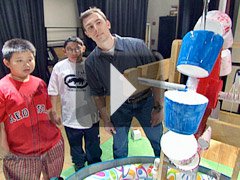Why Should Schools Embrace Integrated Studies?: It Fosters a Way of Learning that Mimics Real Life
Integrated studies allows students to gain knowledge in a truly interdisciplinary fashion.
In today's dynamic global economy, centered on the development and exchange of knowledge and information, individuals prosper who are fluent in several disciplines and comfortable moving among them. Creativity, adaptability, critical reasoning, and collaboration are highly valued skills. When it comes to fostering those skills in the classroom, integrated study is an extremely effective approach, helping students develop multifaceted expertise and grasp the important role interrelationships can play in the real world.
Integrated studies, sometimes called interdisciplinary studies, brings together diverse disciplines in a comprehensive manner, enabling students to develop a meaningful understanding of the complex associations and influences within a topic. A happy by-product of this approach, which is often coupled with project-based learning, is that it makes school more interesting and productive for students and teachers.
"The Logic of Interdisciplinary Studies," an exhaustive 1997 research report, found broad consensus among dozens of researchers as to what the report called the "positive educational outcomes" for students in an integrated- studies program:
- Increased understanding, retention, and application of general concepts.
- Better overall comprehension of global interdependencies, along with the development of multiple perspectives and points of view, as well as values.
- Increased ability to make decisions, think critically and creatively, and synthesize knowledge beyond the disciplines.
- Enhanced ability to identify, assess, and transfer significant information needed for solving novel problems.
- Promotion of cooperative learning and a better attitude toward oneself as a learner and as a meaningful member of a community.
- Increased motivation.
One integrated-studies success story is playing out every day at High Tech High, in San Diego, California, where interdisciplinary curriculum and project learning have propelled 100 percent of the school's graduates to college acceptance; 80 percent of those enroll in four-year institutions. Larry Rosenstock, High Tech High's founding principal and now CEO, explains that the school's approach is not an end in itself, but rather "a means of restructuring the American high school experience for kids." How students learn at High Tech High closely resembles the varied ways in which any of us acquire knowledge and apply skills in the experientially kaleidoscopic real world.
For instance, to create a series of field guides about San Diego Bay, High Tech High students work with a team of the school's biology, math, and humanities teachers, researching, writing, and producing the books. So far, five guides have been published to excellent reviews.

Although integrated studies has been around in one form or another for nearly a century, the approach has won newfound acceptance in recent years, thanks to effective advocate-practitioners like Rosenstock and the many on-the-ground success stories coming out of schools across the country.
After all, our daily life and work are not stratified into "the math part, the science part, the history part, and the English part," Rosenstock points out. "Kids don't experience the world that way." Instead, they -- and all of us -- live in a truly interdisciplinary fashion.
Return to our Integrated Studies page to learn more, or read an extended version of this article with comments by experts Sir Ken Robinson and Heidi Hayes Jacobs and more details about High School High's San Diego field guides.